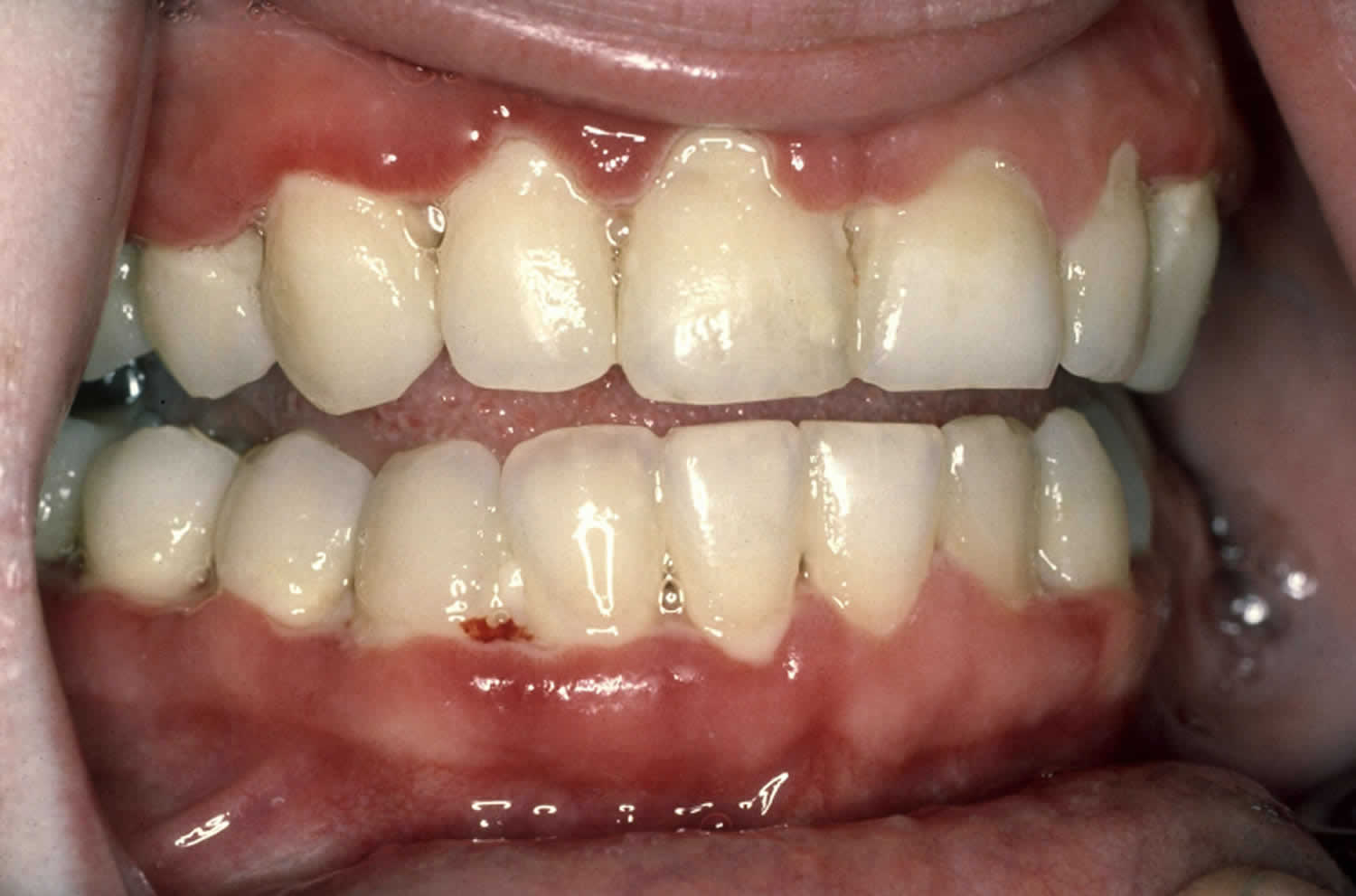Vincent angina
Vincent’s angina also known as acute necrotizing ulcerative gingivitis, trench mouth, Vincent stomatitis or Vincent stomatitis, is an acute and painful infection of the tooth margins and gums that is caused by the symbiotic microorganisms Bacillus fusiformis and Borrelia vincentii. The chief symptoms are painful, swollen, bleeding gums; small, painful ulcers covering the gums and tooth margins; and characteristic bad breath. The ulcers may spread to the throat and tonsils. Fever and malaise may also be present. Vincent’s angina can occur after a prolonged failure to brush one’s teeth, though there are many other predisposing factors, such as vitamin deficiencies, emotional stress, and so on. Diagnosis is based on clinical findings. The infection is readily treated by bed rest, the administration of penicillin or other antibiotics, and the use of antiseptic mouth rinses. Regular tooth brushing is the chief preventive measure.
Figure 1. Vincent’s angina
Footnote: This rapidly progressing infection is characterized by acute fiery-red gingivitis, soft-tissue necrosis with formation of a necrotic surface layer (referred to as a pseudomembrane), severe pain, fetid odor, and, at times, malaise, lymphadenopathy, and low-grade fever. The hallmark sign of Vincent’s angina is necrosis and cratering of the interproximal papillae, referred to as “punched-out papillae.”
Vincent’s angina causes
Vincent’s angina or acute necrotizing ulcerative gingivitis occurs most frequently in smokers and debilitated patients who are under stress. Other risk factors are poor oral hygiene, nutritional deficiencies, immunodeficiency (eg, HIV/AIDS, use of immunosuppressive drugs), and sleep deprivation. Some patients also have oral candidiasis.
Vincent’s angina symptoms
The usually abrupt onset may be accompanied by malaise or fever. The chief signs and symptoms of Vincent’s angina are:
- Acutely painful, bleeding gingivae
- Excessive salivation
- Sometimes overwhelmingly foul breath (fetor oris)
Ulcerations, which are pathognomonic, are present on the dental papillae and marginal gingiva. These ulcerations have a characteristically punched-out appearance and are covered by a gray pseudomembrane. Similar lesions on the buccal mucosa and tonsils are rare. Swallowing and talking may be painful. Regional lymphadenopathy often is present.
Often, Vincent’s angina can manifest without a significant odor, and it also may manifest as a localized condition.
Vincent’s angina diagnosis
Vincent angina diagnosis is based on clinical findings. Rarely, tonsillar or pharyngeal tissues are affected, and diphtheria or infection due to agranulocytosis must be ruled out by throat culture and complete blood count when the gum manifestations do not respond quickly to conventional therapy.
Vincent’s angina treatment
Treatment of Vincent’s angina consists of gentle debridement with a hand scaler or ultrasonic device. Debridement is done over several days. The patient uses a soft toothbrush or washcloth to wipe the teeth.
Rinses at hourly intervals with warm normal saline or twice a day with 1.5% hydrogen peroxide or 0.12% chlorhexidine may help during the first few days after initial debridement.
Essential supportive measures include improving oral hygiene (done gently at first), adequate nutrition, high fluid intake, rest, analgesics as needed, and avoiding irritation (eg, caused by smoking or hot or spicy foods). Marked improvement usually occurs within 24 to 48 hours, after which debridement can be completed.
If debridement is delayed (eg, if a dentist or the instruments necessary for debridement are unavailable), oral antibiotics (eg, amoxicillin 500 mg every 8 hours, erythromycin 250 mg every 6 hours, or tetracycline 250 mg every 6 hours) may help to provide relief and can be continued until 72 hours after symptoms resolve.
If the gingival contour inverts (i.e., if the tips of papillae are lost) during the acute phase, surgery is eventually required to prevent subsequent periodontitis.
Vincent’s angina prognosis
Untreated, the infection may lead to rapid destruction of the periodontium and can spread, as necrotizing stomatitis, into neighboring tissues in the cheeks, lips or the bones of the jaw. Vincent’s angina can occur and be especially dangerous in people with weakened immune systems. This progression to necrotizing stomatitis is possible in malnourished susceptible individuals, with severe disfigurement possible.






